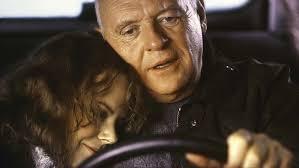 The Human Stain (2003) is another underwhelming Philip Roth adaptation. Robert Benson approaches the material with respect, but can't overcome the material's inherent flaws. The biggest shortcomings, however, may be its utterly baffling cast.
The Human Stain (2003) is another underwhelming Philip Roth adaptation. Robert Benson approaches the material with respect, but can't overcome the material's inherent flaws. The biggest shortcomings, however, may be its utterly baffling cast. Coleman Silk (Anthony Hopkins) is Dean of a small Massachusetts college in the late '90s, until he utters a comment mistaken for a racial epithet. Quitting in a rage (and losing his wife to a heart attack), Silk enlists writer Nathan Zuckerman (Gary Sinise) to write a scathing memoir, while carrying on with cleaning lady Fauna Farley (Nicole Kidman). Slowly, Silk unveils his true secret: that he's a black man passing for white. As if this weren't complicated enough, Silk and Zuckerman also must deal with Fauna's deranged ex-husband Lester (Ed Harris).
More than American Pastoral, The Human Stain strains credulity by its nature. It works on page because Roth uses Silk as a symbol for submerged identity while fleshing out his repressed guilt and divided identity: he trades one minority for another, only to ensnare himself in the foibles of modern identity politics. Similarly, Fauna (a troubled woman who's willed herself into illiteracy) isn't anything like a realistic character; she's a handy embodiment of the uncomplicated affection Silk demands from the world, while paralleling his own detachment from identity. We don't require that novels resemble reality, so long as they evoke mood, themes, deeper truths buried beneath everyday experiences.
Film isn't forgiving of such exaggeration, outside of broad comedies or avant garde works with no pretense to realism. It's not an issue of accepting racial passing as a theme, but accepting these characters, their relationships and conflicts as dramatically believable. Two symbols screwing each other doesn't work unless there's a reason they're screwing. Nor can younger Coleman pounding a dark-skinned black man in the boxing ring, or Fauna's prized raven, avoid seeming crushingly literal. Benson and writer Nicholas Meyer try teasing out depth through flashbacks, protracted dialog and precise, elegant montage, but only intermittently succeed.
Thus The Human Stain exists in a bizarre limbo, partially aware of its handicaps but unable to resolve them. Silk and Fauna's relationship constantly threatens to unravel at the slightest pressure, yet they stay together to appease the plot. Silk's arsing about with Zuckerman seems pointless without Roth's authorial voice, while Lester's just another deranged Vietnam vet trapped a private hell. Characters ranting about Bill Clinton, Viagra and political correctness seem less a commentary on Coleman's dilemma than an angry Roth ranting about pet hates. Maybe these passages weren't any better in the original book; if so, we can thank Benson for exposing their asininity.
Perhaps The Human Stain would work better if the casting wasn't so awful. Anthony Hopkins simply isn't convincing as a Newark Jew, let alone a light-skinned black man pretending to be such. He commits to the role with restraint and intelligence, but once Coleman's secret is revealed (with Wentworth Miller as his younger form) it's impossible to take him seriously. Nicole Kidman is similarly wrong-footed, but in fairness her character probably wouldn't work even in Meryl Streep's hand. Gary Sinise and Ed Harris do little with underdeveloped roles.
As a novel, The Human Stain is deeply flawed and implausible, but well-written, insightful and fascinating. As a movie, it's a garbled mess, with adaptation magnifying its weakness. If the movie showed a modicum of cleverness, we could take its bad casting and confused rendering of the material as a meta reflection on Roth's themes of identity and loss. Sadly, it's just a lousy movie.

